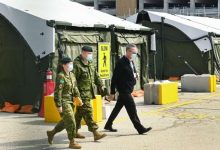How one hospital tackles hallway medicine, starting in the emergency room
One Ontario hospital is trying to lessen its “hallway medicine” problem by forming a new team of health-care workers in its emergency room with the aim of reducing admission rates among seniors.
The “ED One Team” at Sunnybrook Health Sciences in Toronto launched in late October and is already showing evidence of success, according to figures provided by hospital officials that suggest a nearly five per cent drop in admissions.
The team brings together a social worker, a geriatric emergency medicine nurse, a physiotherapist, an occupational therapist, a community care co-ordinator, a psycho-geriatric case manager and staff from agencies that provide home-care services.
The team helps patients who come to the emergency room avoid being admitted to the hospital by ensuring adequate supports are available for them at home or in the community. Its target group is those aged 70 and older who don’t need to be admitted, but who can’t otherwise go home safely straight from the emergency room.
The team has helped Sunnybrook “reduce the number of patients who are in hallways in our emergency department, as well as the number of patients who are stuck in the waiting room,” said Dr. Aikta Verma, the hospital’s chief of emergency services.
“I’m really proud of the work that the team has been doing here,” Verma told CBC News. “This has really made a difference for us in terms of being able to lower our admissions.”
Verma pointed to the recent case of an older patient who came to the emergency room with what the doctor described as a “very minor” foot fracture but was unable to walk.
A year ago, said Verma, she would have decided that the patient needed to stay in hospital. Instead, Verma contacted the ED One Team, whose members taught the patient how to walk with support, got her the equipment she needed to be safe at home, and avoided admission.
“This was better for the patient as well as for the system overall,” said Verma.
Sunnybrook hopes the team’s efforts will help alleviate some of the demand for beds that has led to the “hallway health-care” trend on its wards and in hospitals across the province.
An investigation by CBC News last month revealed dozens of Ontario hospitals were filled beyond capacity for weeks at a time in 2019. The data showed Sunnybrook with a higher than 100 per cent occupancy rate on 47 days in the six-month period analyzed.
Premier Doug Ford has promised to end hallway medicine. The government’s statistics show a five-to-six per cent drop over the past year in the number of hospital patients in “unconventional spaces” such as hallways and storage rooms, but that still means some 950 patients are falling into that category every day.
Sunnybrook’s ED One Team operates seven days a week from 8 a.m. until 11 p.m., working with the emergency department medical staff to identify patients who don’t need hospital admission, but need some form of extra care.
That could include physiotherapy right in the emergency room, something that previously was only provided to patients who’d been admitted, unnecessarily taking up a hospital bed sometimes for days.
Physiotherapist Belinda Wagner said the team typically sees patients who come to the ER with an injury or an illness that affects their ability to function safely at home but who don’t require a hospital stay.
“If they’re medically stable and they’re ready to leave this level of care but not necessarily go home safely, we as a team can put our brains together and figure out what is the best next place for them to go,” said Wagner.
Team member and social worker Valerie Soper says it’s “fantastic because we all come to the table with a different lens and there’s so many improvements that have been made in the emergency department.”
Soper worked in Sunnybrook’s ER long before the formation of the team and said the change has meant each professional’s work gets done more efficiently, patients’ needs are being met in a more timely fashion, and discharges happen more quickly.
By working until 11 p.m., the team can set up home-care supports that typically only get arranged during the daytime.
“We’re able to see patients in the evening and facilitate a safe discharge home instead of having these patients stay overnight,” said occupational therapist Faith Gallant, one of the team members.
In its health-care reforms, the Ford government is encouraging hospitals to work more directly with outside agencies such as home-care providers with the aim of improving connections within the health system for patients.
Sunnybrook’s ED One Team is putting that into practice in a range of ways:
- Doing physiotherapy or occupational therapy assessments in the ER makes it possible to refer patients directly to a physical rehab facility without the patient having to wait in the hospital.
- Home-care agencies involved in the team can arrange for a personal support worker to accompany the patient home.
- A psycho-geriatric case manager keeps tabs on patients at home after discharge to reduce the risk of re-admission.
The emergency department has seen a 4.5 per cent reduction in admission rates among the team’s target caseload since the launch in October, according to hospital officials. That has meant 74 fewer patients admitted to the hospital’s already crowded wards.
There’s also been a noticeable increase in patient satisfaction with the hospital experience, said Natalie Coyle, the team’s co-ordinator.
“We’ve heard from some patients who have written in to say, ‘It was really great that someone followed up with me and was able to provide extra service and ensure that I was safe,'” said Coyle.
CBC








Redes Sociais - Comentários